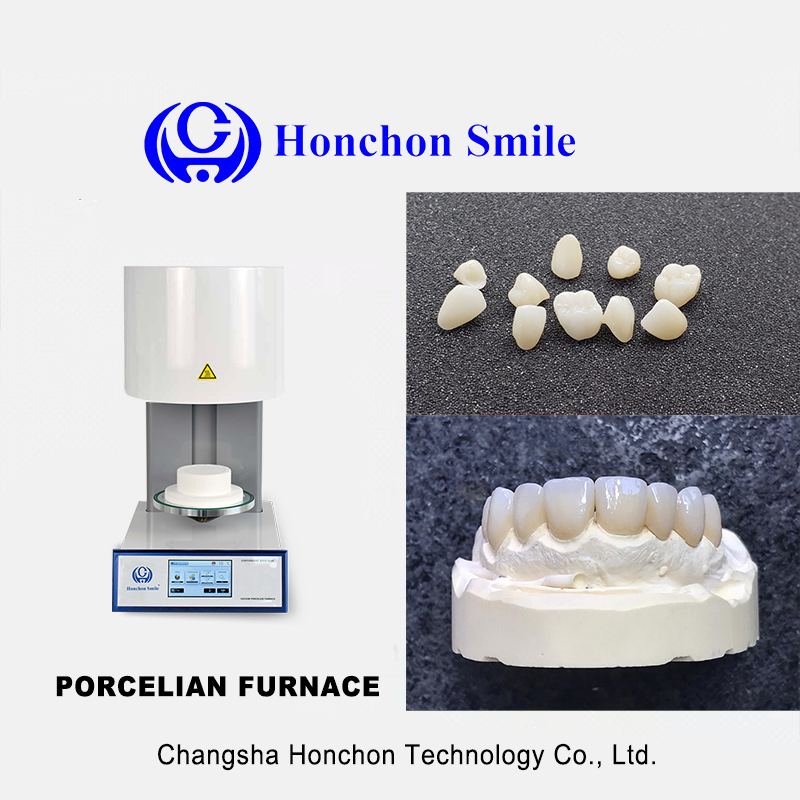A dental porcelain furnace is one of the most important pieces of equipment in a dental lab. Whether you are producing zirconia crowns, ceramic veneers, or metal-ceramic restorations, choosing the right furnace will directly affect your restoration quality, color accuracy, and long-term efficiency.
This guide explains what to look for when purchasing a dental porcelain furnace, so you can make an informed decision for your lab or your clients.

A porcelain furnace is used to sinter, glaze, and crystallize dental restorations such as zirconia, lithium disilicate, and porcelain veneers.
It must provide:
Stable temperature control
Vacuum environment for porcelain firing
Accurate temperature curve programming
The right furnace helps achieve natural translucency, perfect surface texture, and strong bonding strength.
Different materials require different firing temperatures:
Zirconia sintering: up to 1550°C
Glass ceramics: around 850–900°C
Porcelain glaze: about 750–950°C
Choose a furnace that covers your most frequent material types and maintains temperature accuracy within ±1°C.
The heating element determines heating stability and lifespan:
Molybdenum disilicide (MoSi₂): ideal for zirconia sintering furnaces
Quartz or high-purity alumina chamber: resists contamination and cracking
A high-quality heating chamber ensures uniform heat distribution and long-term durability.
For porcelain firing and veneering, a strong and stable vacuum pump is essential.
It helps remove air bubbles and achieve smooth, dense porcelain surfaces.
Check that the furnace allows automatic vacuum control and customizable hold time.
Modern dental furnaces feature touchscreen interfaces with programmable firing curves.
Look for:
Intuitive software
Memory storage for multiple programs
Real-time temperature curve display
Safety functions (overheat and power-failure protection)
This helps technicians standardize production and reduce human error.
Dental labs should choose the furnace size based on production volume:
Single-chamber small furnaces – for daily restorations (1–3 units per cycle)
Large sintering furnaces – for batch processing of 20–50 crowns
Ensure the inner chamber fits your milling system’s disc and restoration sizes.
Confirm that the furnace supports your local voltage (e.g., 220V or 110V) and frequency (50/60Hz).
Some regions require voltage stabilizers for precise temperature control.
Fast Cooling System – saves time between cycles
Automatic Door Lifting – safer and more convenient operation
Pre-set Programs for Zirconia and E.max – easy for beginners
Energy-Saving Mode – reduces power consumption in large labs
To extend the life of your porcelain furnace:
Clean the chamber regularly and avoid material spillage
Check the thermocouple and heating elements periodically
Use only compatible firing trays and supports
Keep the vacuum pump oil clean and at the proper level
Always follow the manufacturer’s firing parameters for each material.
| Feature | Recommendation |
|---|---|
| Temperature Range | 750°C–1550°C |
| Accuracy | ±1°C |
| Chamber | High-purity alumina or quartz |
| Vacuum | Strong & stable, programmable |
| Interface | Touchscreen, programmable curves |
| Voltage | 110V/220V (depending on region) |
At HONCHON, we design and manufacture dental equipment, including porcelain furnaces, zirconia milling machines, and CAD/CAM materials.
Our furnaces are compatible with a wide range of dental ceramics and feature precise temperature control, easy programming, and stable vacuum systems—ideal for both small and large dental labs.
If you need help choosing the right furnace model for your lab or your customers, our technical team is happy to assist with detailed recommendations.
In summary:
A good dental porcelain furnace is not just about high temperature — it’s about accuracy, stability, and convenience. Choosing the right one will improve restoration quality, reduce waste, and increase lab productivity.